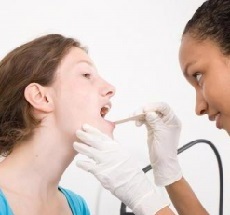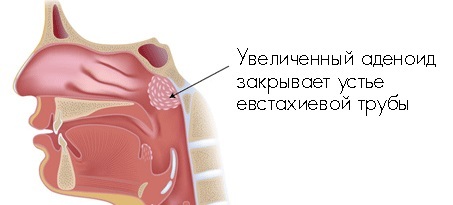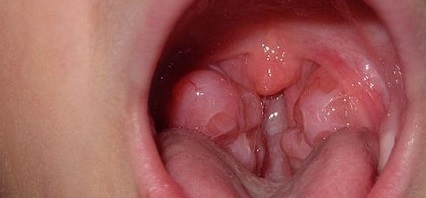 Adenoids are the tonsils located in the nasopharynx and are the first barrier for infections and bacteria. Inflammation of the pharyngeal tonsils - adenoiditis - regularly affects children 3-7 years old, and have suffered such diseases as measles, scarlet fever.
Adenoids are the tonsils located in the nasopharynx and are the first barrier for infections and bacteria. Inflammation of the pharyngeal tonsils - adenoiditis - regularly affects children 3-7 years old, and have suffered such diseases as measles, scarlet fever.
At the age of 10-12 years, when the immune system is almost completely formed, the pharyngeal tonsil decreases and disappears. But doctors record the presence of adenoids in some adults. Symptoms and treatment of this problem will be considered in this article.
Reasons for
Adenoids in adults may appear for various reasons, including in connection with genetic characteristics. Such adenoids can remain from the very childhood. But most often the cause of the proliferation of adenoids are frequent and long-lasting inflammatory diseases of the nasopharynx.
Since the nasopharyngeal tonsil consists of lymphoid tissue( this tissue delays the infection), then it grows with infection. If the infection has passed quickly, the tonsil also decreases rapidly, and if the process is prolonged, adenoids may appear.

Symptoms of Adenoids in Adults
The primary symptoms of adult adenoids practically do not differ from the signs of adenoids in children:
- snoring;
- obstructed nasal breathing;
- permanent nasal congestion;
- purulent discharge from the nasal passages for colds;
- nasal and / or hoarseness of the voice;
- headache - occurs due to oxygen starvation, which affects all the systems and organs of the body and, in the first place, the brain;
- frequent diseases( acute respiratory disease, rhinitis, sinusitis, otitis media, sinusitis).
Just like in the case of a child, "adulthood" adenoids are of different degrees. At , the first stage of breathing is difficult only at night, complications may not occur during the day. If the form of the disease is acute, the temperature may rise. The second and third stages of smoothly pass from one to another, therefore their symptoms are practically not shared and refer to them as follows:
- purulent discharge from the nose in large quantities;
- the person practically does not breathe;
- is snoring in sleep, at the third stage, the breathing of a sleeping person is possible;
- shows a dry cough in the morning, which can disturb the day;
- pronounced breathing through the mouth.
An otorhinolaryngologist and modern research methods can distinguish adenoiditis from a common cold.
Adenoids in adults: photo
How adenoids look in the nose in an adult, we offer detailed photos to view.

Diagnosis
Without a rhinoscope to make an accurate diagnosis or even identify a suspicion is almost impossible. The nasopharynx of an adult person is very different from the structure of the nasopharynx of a child, therefore a primary examination with finger research is absolutely not informative, therefore, a rhinoscopy is appointed with a similarity of adenoid symptoms in adults.
Treatment of Adenoids in Adults
When adenoids are detected in adults, treatment with conservative methods can be performed only when the adenoids are of the first degree. If the nose is heavily embedded, then the vasoconstrictive medication is instilled for several days or the mouth is gelled with a tincture of eucalyptus. With a more severe exacerbation, adenoid treatment in adults is carried out with antibiotics, previously revealing the sensitivity of the causative agents of the infection.
And how to treat adenoids in adults, when they are large - the second and third degree. In this case, surgical intervention is necessary. In general, an unambiguous indication for the removal of adenoids is the impossibility of nasal breathing. If the nose does not breathe, you nightly risk falling asleep and no longer wake up. It sounds creepy, but stopping breathing in a dream is a well-known medicine phenomenon.
In addition, even during wakefulness, constant breathing through the mouth causes the mucous throat to dry out - and from this, perspiration, dry cough. Not fatal, but all this prevents you from resting, working, generally living. .. and over time, permanent nasal congestion can cause increased fatigue and frequent headaches.
Removal of adenoids
To date, there are two ways to remove adenoids( adenotomy) in surgery:
- Using the endoscope .In the nasal cavity a tube is inserted, at the end of which there is a television camera( endoscope).Using microsurgical instruments, the doctor removes the tonsil through the nose or mouth. The operation is under general anesthesia and lasts 30-60 minutes.
- With the use of a special surgical instrument - adenotoma .The operation is performed in a hospital under local anesthesia. In the nasal cavity of the patient, the doctor introduces a thin knife in the form of a ring( adenotome), which is captured and cut off by the adenoids. The procedure takes about 20 minutes.
Folk remedies for the treatment of this disease is better not to use. Incorrectly taken measures can give serious complications that will affect the patient's condition in the future.

How to choose probiotics for the intestines: a list of drugs.

Effective and inexpensive cough syrups for children and adults.

Modern non-steroidal anti-inflammatory drugs.

Review of tablets from the increased pressure of the new generation.
 Antiviral drugs are inexpensive and effective.
Antiviral drugs are inexpensive and effective.



